
Aralia spinosa, commonly known as devil's walking stick, is a woody species of plant in the genus Aralia, family Araliaceae, native to eastern North America. The various names refer to the viciously sharp, spiny stems, petioles, and even leaf midribs. It has also been known as Angelica-tree.

Acer circinatum, or vine maple, is a species of maple native to western North America. Vine maple typically grows as a low-elevation costal tree in temperate areas of high precipitation such as the west coast of Oregon and northern California, as well as the rain forests of Washington State and British Columbia. Vine maples play an important role in conserving the biodiversity of lowland ecosystems by enriching upper soil layers and providing habitat for other organisms.

Acacia cardiophylla, commonly known as West Wyalong wattle or Wyalong wattle, is an evergreen shrub that is endemic to eastern Australia.

Pterocarpus angolensis is a species of Pterocarpus native to southern Africa, in Angola, Mozambique, Namibia, South Africa, Eswatini, Tanzania, Democratic Republic of the Congo, Zimbabwe, and Zambia. It is a protected tree in South Africa. The name Kiaat, although Afrikaans, is sometimes used outside South Africa as well. In Zimbabwe, depending on what region you are in, it is known as Mukwa( which it is also called in Zambia) or Mubvamaropa.
Terminalia schimperiana is a species of Terminalia, native to tropical Africa from Guinea and Sierra Leone east to Uganda and Ethiopia.

Anogeissus leiocarpa is a tall deciduous tree native to the savannas of tropical Africa.
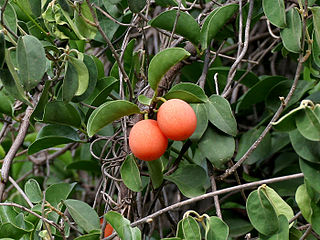
Ximenia americana, commonly known as tallow wood, hog plum, yellow plum, sea lemon, or pi'ut (Chamorro), is bush-forming shrub/small tree; a species from the Ximenia genus in the Olacaceae family. It is mainly found in the tropics, ranging from Africa, India and southeast Asia, to Australia, New Zealand, Pacific Islands, West Indies, Central, North and South America. It is especially common in Africa and South America. It is not domesticated so it is only found occurring in the wild.

Ochna serrulata is an ornamental garden plant in the family Ochnaceae which is indigenous to South Africa. It is planted in southern African gardens and is an invasive species in Australia and New Zealand.

Moringa stenopetala, commonly known as the African Moringa or cabbage tree, is a deciduous tree in the plant genus Moringa, native to Kenya and Ethiopia. A drought-resistant species, it is characterized by its bottle-shaped trunk, long twisted seed pods, and edible leaves likened to cabbage, from which its common name is derived. M. stenopetala is extirpated in the wild in Ethiopia, though still grown there as a crop on the terraces of the Ethiopian Highlands, mainly in the Konso region.

Berberis aristata, also known as Indian barberry, Mara manjal (மரமஞ்சள்),"chutro" or "sumbal" ortree turmeric, is a shrub belonging to the family Berberidaceae and the genus Berberis. The genus comprises approximately 450-500 species of deciduous evergreen shrubs and is found in the temperate and sub-tropical regions of Asia, Europe, and the Americas. B. aristata is native to the Himalayas in India and in Nepal. It is also naturally found in the Nilgiri Mountains of southern India and in Sri Lanka.
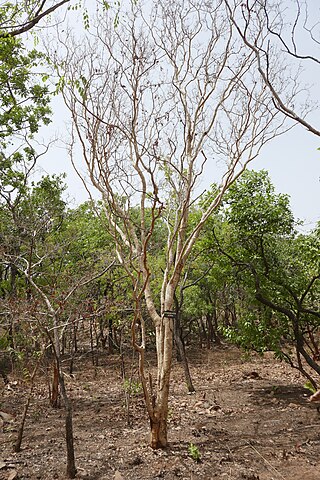
Hymenocardia acida is a plant of the family Phyllanthaceae native to tropical Africa. It is a small tree that grows to 10 m tall. Occurs in the Guinea and Sudanian savannah zones and deciduous woodland, from Senegal eastwards to Ethiopia and southwards reaching Zimbabwe.

Maesa lanceolata, the false assegai, is a tree species that is widespread in the Afrotropics, including Madagascar. It occurs from the southern Arabian Peninsula, southwards to the Eastern Cape, South Africa. It grows on stream verges, river banks and forest verges, where it is often a pioneer plant.

Fockea multiflora, or python vine, is a plant of the dogbane family, Apocynaceae, native to Tanzania, Mozambique, Zimbabwe, Zambia, Angola, Botswana, Namibia, including the Caprivi Strip, and Malawi. It is a large semisucculent liana, growing to some 15m in length and up to 60 cm in diameter, found primarily in the seasonally dry tropical biome.
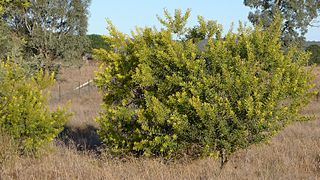
Acacia rubida, commonly known as red stem wattle, red stemmed wattle or red leaved wattle, is a shrub belonging to the genus Acacia and the subgenus Phyllodineae that is native to parts of eastern Australia.
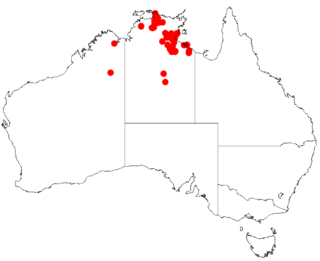
Acacia conspersa is a shrub or tree belonging to the genus Acacia and the subgenus Juliflorae that is native to northern Australia.

Acacia excelsa, also known as ironwood, rosewood, bunkerman and doodlallie is a tree of the genus Acacia and the subgenus Plurinerves that is endemic to inland parts of north-eastern Australia. In the Gamilaraay language it is known as dhan, gayan or gan.
Piliostigma reticulatum is a legume in the Cercidoideae subfamily. It occurs throughout western tropical Africa to Ethiopia.

Ficus asperifolia is a species of shrub or small sized gynodioecious fig tree belonging to the family Moraceae. It grows up to 6 m high and often has climbing branches.
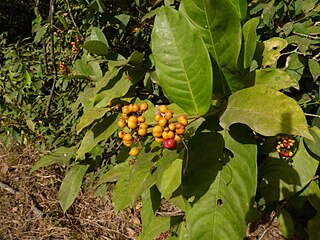
Ixora brachypoda is a species of shrub or small tree in the family Rubiaceae. It has fragrant flowers and glabrous leaves and stems.

Ficus laurifolia is an hemi-epiphytic species that sometimes grows as a shrub or liana or as a tree, the species is within the family Moraceae.


















